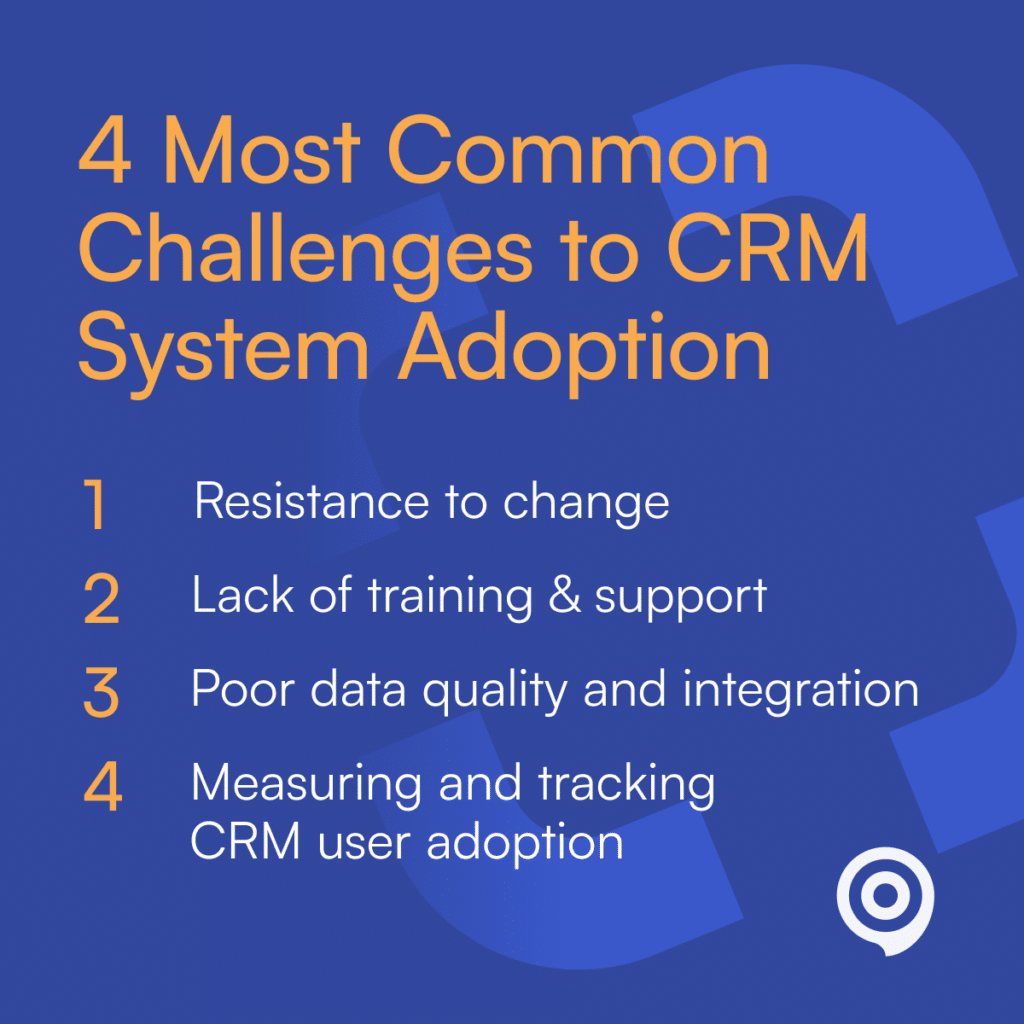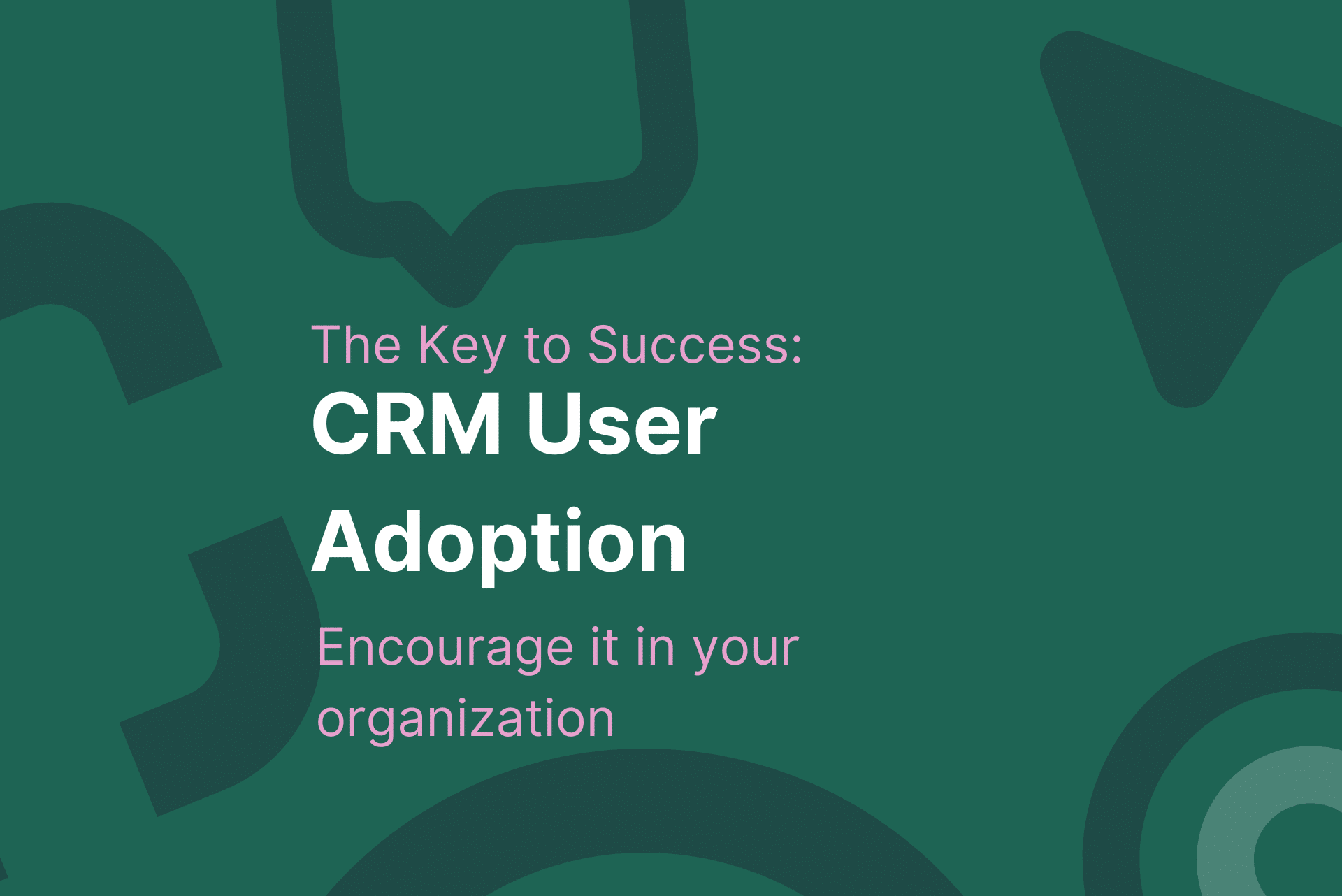Understanding CRM user adoption
CRM systems offer a centralized platform for managing customer data, streamlining sales and business processes, and enhancing customer service. However, without widespread user adoption, the real benefits of CRM remain untapped. Successful CRM user adoption is advantageous for many reasons; organizations commonly report increased efficiency, better customer insights, and improved decision-making.
Despite its importance, CRM implementations can be challenging. Common CRM adoption challenges include resistance to change, lack of training and support to properly onboard the CRM platform, as well as poor data quality and integration options. Overcoming these challenges requires a systematic approach and strategic initiatives when the new CRM software is initially introduced to the team.

To effectively get end users onboarded to your new CRM, it’s important to not underestimate the role of change management during software adoption.
Comprehensive CRM adoption strategy
To effectively improve CRM adoption, organizations can implement a combination of strategies aimed at fostering engagement, promoting user-centric design, and creating a supportive environment including:
- Leadership and management support
- User-centric design and training
- Clear communication and expectations
- Incentives and recognition
- Customization and personalization
- Mobile CRM adoption
- Gamification
- Continuous training and skill devel0pment
- Integration with AI and automation
- Overcoming user reluctance
- Cross-departmental collaboration
- CRM implementation and customer experience
- Success stories and best practices
Find out more about each strategy and get examples on how to execute each one.
Leadership and management support
Leadership and management support play a pivotal role in driving CRM adoption rates. When executives and managers actively champion the new CRM platform, it sets a positive example for the rest of the organization.
For instance, the CEO can communicate the vision and strategic importance of the new CRM solution and effective end user adoption, emphasizing how the new CRM tool aligns with the organization’s growth objectives and customer-centric focus. Leadership’s involvement sends a strong message to employees about the significance of the new CRM and encourages the rest of the team to embrace the system.
Managers, as key influencers, can promote CRM adoption by not only emphasizing the benefits but also actively participating in the tool’s implementation.
They can conduct regular team meetings to discuss the advantages of the CRM tool and how it can improve workflows, business processes, and customer relationships. Managers should also provide guidance and support to their teams, ensuring everyone has the necessary resources and training to effectively use the new CRM system.
By actively engaging with employees, managers can address concerns, share success stories, and foster a positive attitude towards CRM adoption throughout the organization.
User-centric design and training
User-centric design and comprehensive training programs are essential elements for successful CRM adoption. Investing in a well-designed CRM tool that is intuitive, visually appealing, and aligned with users’ needs can significantly improve CRM adoption rates.
Organizations can identify pain points, preferences, and user workflows to customize the CRM interface accordingly by conducting user research and gathering feedback during the design phase. This customization reduces the learning curve and resistance to using the new CRM system, making it more user-friendly and intuitive.
Comprehensive training programs ensure users understand the CRM system’s functionalities, benefits, and how it relates to their specific roles and goals.
Training should encompass both initial onboarding and ongoing support. Interactive workshops, online training modules, and hands-on practice sessions help familiarize users with the CRM’s features and best practices.
Additionally, organizations can provide user guides, FAQs, and helpdesk assistance to serve as ongoing resources for those CRM users who use the software heavily on a daily basis, like the sales team. By investing in user-centric design and comprehensive training, organizations empower their employees to leverage CRM tools effectively and maximize their potential.
Clear communication and expectations
Clear communication and setting realistic expectations are vital for successful CRM adoption. Organizations need to communicate the benefits, goals, and objectives of CRM implementation clearly and consistently throughout the adoption process.
By emphasizing how CRM adoption improves customer relationships, streamlines business processes, and supports business growth, employees can understand the real business value it brings to their work. Regular communication channels such as company-wide meetings, newsletters, and training sessions should be utilized to keep employees informed and engaged throughout the CRM implementation project.
Setting clear expectations for CRM adoption metrics, general usage, and data entry ensures accountability and reinforces the importance of the CRM as a shared responsibility. Organizations should establish guidelines and documentation for proper CRM usage, data quality, and workflows to ensure consistency and maximize the system’s effectiveness from day one.
Regularly communicating the impact of CRM adoption through success stories, metrics, and positive outcomes further motivates employees to embrace the new system. By aligning CRM usage expectations with performance goals and evaluations, organizations can emphasize the importance of accurate data entry and CRM utilization as integral parts of employees’ roles.

Successful CRM adoption relies on effective leadership and management support, user-centric training, and open and candid environment that fosters communication.
Incentives and recognition
Motivation is a powerful driver of CRM end user adoption. Organizations can introduce incentives and recognition programs to encourage employees to actively use the CRM system and demonstrate its value.
For example, rewards, bonuses, or recognition can be given to top CRM users or teams who consistently show exemplary usage, innovation, or successful outcomes. This recognition not only reinforces the importance of CRM adoption but also fosters a culture of engagement and continuous improvement.
Incentives and recognition can be tailored to align with CRM usage goals and specific organizational objectives. For instance, organizations can acknowledge employees who have successfully utilized the CRM system to close significant deals, improve customer satisfaction ratings, or increase sales productivity.
By publicly recognizing their achievements and sharing best practices, other employees are encouraged to follow suit and embrace the CRM system. Additionally, organizations can create friendly competitions or challenges to promote CRM adoption and offer rewards to individuals or teams who achieve specific milestones or demonstrate exceptional performance. Incentives and recognition programs help organizations create a positive environment that not only encourages software adoption but also drives a culture of excellence and collaboration.
Customization and personalization
Customization and personalization options within CRMs are crucial to improve CRM user adoption.
By tailoring the CRM features, interface, workflows, and data fields to meet the specific needs and preferences of your CRM users and teams, organizations can enhance the user experience and increase adoption rates.
For example, allowing users to customize their dashboards, create personalized reports, and configure notifications based on their roles and priorities empowers them to work more efficiently and effectively within the CRM system.
Mobile CRM adoption
With the ever-increasingly mobile workforce, mobile CRM adoption has become imperative. The ability to access CRM systems on mobile devices enables users to stay connected and productive while on the go or working remotely.
Organizations should promote mobile CRM adoption by providing mobile-friendly CRM interfaces and applications, ensuring seamless synchronization between desktop and mobile versions, and highlighting the benefits of mobile access, such as real-time data updates, remote collaboration, and improved responsiveness to customer needs.
Gamification
Gamification can be a powerful tool to incentivize CRM user adoption. By incorporating game-like elements into the CRM experience, organizations can make CRM usage highly engaging and more enjoyable for users – resulting in better adoption rates overall.
Leaderboards, challenges, and rewards can motivate users to actively engage with the CRM system, compete with colleagues, and achieve performance goals, while executing daily sales and marketing efforts.
Gamification fosters a sense of achievement, healthy competition, and camaraderie among users, ultimately driving higher CRM adoption rates.
Continuous training and skill development
Organizations should prioritize continuous training and skill development to ensure a sustained CRM adoption rate and a healthy software ROI. Providing regular training refreshers, advanced training modules, and opportunities for users to enhance their CRM knowledge and skills is crucial for achieving strong CRM adoption rates.
Training programs should focus not only on the technical aspects of CRM usage but also on best practices, new features, and industry trends. Training could also be tailored to specific locales or offered on certain topics, like sensitive customer data handling.
By investing in continuous training, organizations empower users to leverage the full potential of the CRM system and perform better in their roles.
Integration with AI and automation
Integration of artificial intelligence (AI) and automation capabilities within CRM systems can significantly enhance user productivity and drive CRM adoption.
AI-powered features, such as predictive analytics, intelligent recommendations, and automated workflows, streamline processes, enable data-driven decision-making, and save users time and effort.
Organizations should emphasize the benefits of AI and automation in enhancing user efficiency and promoting CRM adoption. For example, being able to automate manual data entry can result in increased sales team efficiency and help end users see the everyday benefits of the CRM strategy.
Overcoming user reluctance
Addressing user reluctance is essential for successful CRM adoption and overall effective change management.
Organizations should proactively address common reasons for reluctance, such as skepticism, fear of change, and concerns about the learning curve.
Open communication, training programs, and providing tangible examples of the positive impact CRM can have on users’ work can help alleviate these concerns and increase user acceptance and enthusiasm for CRM adoption.
Cross-departmental collaboration
It’s important to remember that while a sales team might use the CRM most visibility, many other teams within an organization analyze customer data: marketing departments often need to understand the research and buying phase of the brand’s target audience. Similarly, customer service teams use the same customer data to troubleshoot problems with order shipping or returns.
CRM adoption facilitates cross-departmental collaboration, fostering communication, and information sharing between different teams and departments. By using CRM systems as a centralized platform for customer data and interactions, organizations can break down silos and enable seamless collaboration.
This collaborative approach enhances overall organizational efficiency, ensures consistent customer experiences, and improves interdepartmental alignment toward shared business goals.
CRM implementation and customer experience
CRM adoption directly impacts customer experience and satisfaction. By capturing and analyzing customer data within the CRM system, organizations can gain insights into customer preferences, behavior patterns, and history, enabling personalized interactions and tailored service delivery.
CRM integration with other customer-facing systems, such as marketing automation and customer support platforms, ensures a unified view of customer interactions, empowering employees to deliver exceptional customer experiences.
Highlighting the customer-centric goal of your CRM strategy can help offer tangible and easy-to-understand reasons for the software implementation overall.
Success stories and best practices
Sharing real-life success stories and best practices from organizations that have achieved high CRM user adoption rates can inspire and provide practical insights into how the new software can be used in daily life.
By implementing these strategies in a comprehensive and tailored manner, organizations can create an environment that promotes CRM user adoption and maximizes the benefits that CRM systems offer.
These strategies, when combined with effective change management and ongoing support, can help organizations improve CRM adoption rates, increased productivity, improved customer relationships, and ultimately, a competitive edge in the market.

User adoption is most effective when various learning and training strategies are implemented. End users should also fully understand the benefits of the software adoption in the first place.
Overcoming common challenges in CRM system adoption
CRM adoption can face various challenges within organizations. To ensure successful adoption, organizations can implement strategies to address these challenges:

Resistance to change
Resistance to change is a common barrier to CRM user adoption. Employees may feel apprehensive about transitioning to a new system or fear that it may disrupt their current workflows.
To address this challenge, organizations should proactively address employee concerns and fears through open communication and transparency. Clear and consistent messaging about the benefits of CRM adoption should be emphasized, focusing on how it can positively impact employees’ work and streamline processes.
Sharing success stories and showcasing the achievements of early adopters can help alleviate resistance and demonstrate the value of CRM adoption.
Lack of training and support
Insufficient training and support can also hinder CRM adoption.
Organizations should invest in comprehensive training programs tailored to different user roles and needs. These training programs should not only cover the technical aspects of CRM usage but also emphasize the benefits and practical applications for end users.
Ongoing support mechanisms, such as in-house power users, adoption tools, user forums, helpdesks, and knowledge bases, should be established to provide users with the necessary resources and assistance to overcome challenges. Regular training refreshers and updates should also be provided to ensure users stay up to date with the CRM system’s capabilities.
Poor data quality and integration
Data quality and integration issues can hamper CRM adoption and its effectiveness. Organizations should implement measures to address data quality concerns, such as data quality checks, validation processes, and data governance frameworks.
By establishing clear guidelines and standards for data entry and maintenance, organizations can maintain accurate and reliable data within the CRM system.
Integration of the CRM system with other key systems, such as marketing automation or customer support platforms, is crucial for seamless data flow and reducing manual effort overall. Integrations ensure that users have access to complete, up-to-date, and insightful customer data, increasing the employees’ efficiency and effectiveness.
Measuring and tracking CRM user adoption
To evaluate the success of CRM user adoption, organizations need to establish key metrics and tracking mechanisms. By measuring and analyzing adoption metrics, organizations can gain insights into the level of CRM usage and identify areas for improvement.
Metrics such as user activity, data entry completion rates, and user engagement can provide valuable information on adoption levels and user behaviors. Regular tracking of these metrics helps organizations assess the effectiveness of their adoption strategies and make data-driven decisions to drive continuous improvement efforts.
By proactively addressing these common challenges, organizations can overcome barriers to CRM user adoption and pave the way for successful implementation. A comprehensive approach that combines effective communication, training, support, data quality measures, and performance tracking will help organizations maximize the benefits of CRM systems and drive overall business success.
Case Studies: Successful CRM User Adoption Examples
Highlighting real-world examples of organizations that have achieved high CRM user adoption rates can provide valuable insights and inspiration for your adoption process:
Georg Fischer needed support with fast documentation updates and multilanguage support when it comes to keeping up with all the Dynamics 365 updates. ClickLearn’s Dynamics 365 Customer Engagement solution was exactly what the organization was looking for.
Looking for ways to streamline their technology team’s training and documentation, Open Door was able to optimize and automate business operations with ClickLearn’s Microsoft Dynamics 365 Business Central solution.
Succeed in CRM user adoption
CRM user adoption is the cornerstone of a successful CRM implementation.
By prioritizing strategies such as leadership support, user-centric design, clear communication, and incentives, organizations can overcome adoption challenges and drive meaningful results.
By empowering employees with the right training and support, organizations can unlock the full potential of CRM, enhance customer relationships, and gain a competitive edge in today’s dynamic business landscape.

Do you want to save this for later?
Save this blog post as a PDF and read it when and where you want.





